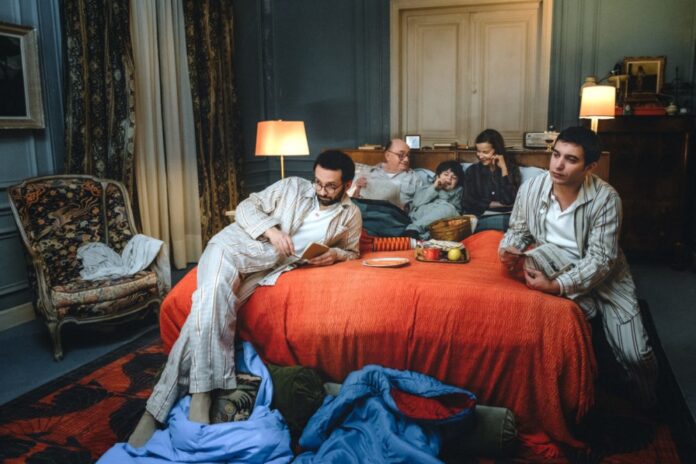In the midst of the 1968 French revolt, Lionel Baier’s “The Safe House” presents a humorous depiction of a family, bursting with potential yet never fully materializing. The film, inspired by Christophe Boltanski’s award-winning biographical novel of the same name, cleverly unfurls in a postmodern style. Despite being filled with deliberately transparent rear projections, it gradually reveals deeper layers as the family’s past becomes apparent. However, it struggles to deliver meaningful political or personal insights.
“The Safe House” uses Boltanski’s family as the backbone of the script but reimagines them, shifting various aspects of the story while maintaining the overall narrative: a tale unfurling around the periphery of one of France’s most crucial modern protests. Initially, the story unfolds through the eyes of a nine-year-old boy (Ethan Chimienti), presumably representing Boltanski himself. Yet, the film frequently deviates from this young character’s perspective, and even Chimienti’s spirited performance, opting for a more fragmented narration, leaving the family’s broader dynamics largely unexplored.

The narration of “The Safe House” introduces us to the boy’s ambitious uncles, the younger a visual artist (Aurélien Gabrielli) and the older an academic (William Lebghil), along with his eccentric grandparents (Michel Blanc and Dominique Reymond) and his vivacious great-grandmother (Liliane Rovère), an immigrant from Odessa. The family’s Jewish heritage becomes crucial in the latter half of the film, but only occasionally surfaces in the opening scenes, hinted at through subtle references and the prejudices of disdainful neighbors.
The initial scenes, brimming with a Jacques Tati-style energy, provide just enough traction for the narrative, until larger political issues pull the boy’s parents (Adrien Barazzone, Larisa Faber) away from their home. Regrettably, they are barely present to begin with, much like the crowded house they inhabit. Despite the narrator’s emphasis on the house’s physical significance, it’s rarely captured in a way that gives a sense of space, dynamism, or detail.
The unfolding of May ’68, largely in the background, alludes to a film where politics is secondary, or at least reflected through subtle non-confrontations. However, “The Safe House” does set the stage for powerful drama around the events, albeit without delving into its specifics. Instead, it echoes the family’s history as Jews during the Nazi occupation through the grandfather’s apparent PTSD (an element that appears as abruptly as it vanishes) and flashbacks that draw tenuous parallels between the two eras. The only apparent link is the march of history – the notion that “something” is happening, even if neither era is portrayed with a sense of broader history or personal relevance.
While the film’s narrative largely detaches from its characters, Baier does manage to evoke the spirits of the past through some of his performances, particularly Blanc’s, which is deeply moving. Nonetheless, this haunting history rarely grounds the family’s story. Instances where 1968 seems directly connected to the 1940s are scarce, and even the ghostly appearance of a prominent World War II figure fails to solidify these links.
The film starts with a playful tone and progresses with a somber feel. But these two halves are only truly unified by the jazz-heavy score by Diego Baldenweg, Nora Baldenweg, and Lionel Baldenweg, which subtly shifts familiar sounds. Visually and thematically, “The Safe House” falls short of its hints of accomplished sonic storytelling, often flitting between expression modes without fully capturing the weight of experience or the burden of personal and cultural memory.
FAQs:
Q: What is “The Safe House” about?
A: The movie is a family saga set against the backdrop of the 1968 French revolution. It attempts to portray the family’s past and how it is echoed in their present, but struggles to deliver a meaningful narrative.
Q: Who directed “The Safe House”?
A: “The Safe House” was directed by Lionel Baier.
Q: What is the source material for “The Safe House”?
A: The film is based on Christophe Boltanski’s Prix Femina-winning biographical novel of the same name.
Q: How is the family’s Jewish heritage portrayed in the film?
A: The family’s Jewish heritage becomes a key focus in the second half of the film. It is hinted at through subtle references and prejudices of disdainful neighbors in the opening scenes.
Q: How does the film depict the May ’68 revolution?
A: The May ’68 revolution plays out in the background, reflecting a film where politics is secondary. However, it does set the stage for powerful drama around the events, albeit without delving into its specifics.
Credit: variety.com


